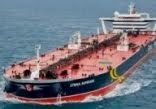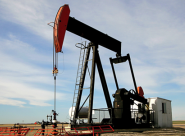Africa Oil reported that it has made a gas discovery in Block 9 onshore Kenya. The Sala-1 drilled a large 80 sq km anticlinal feature along the northern basin bounding fault in the Cretaceous Anza graben and encountered several sandstone intervals which had oil and gas shows. The well was drilled to a total depth of 3030 m and petrophysical analysis indicated three zones of interest over a 1000 m gross interval which were subsequently drill stem tested. An upper gas bearing interval tested dry gas at a maximum rate of 6 mmcfpd from a 25 m net pay interval.
The interval had net reservoir sand of over 125 m and encountered a gas water contact so there is potential to drill up dip on the structure where this entire interval will be above the gas water contact. A lower interval tested at low rates of dry gas from a 50 m potential net pay interval which can also be accessed at the up dip location. It should also be noted that there were oil shows while drilling and small amounts of oil were recovered during drilling and testing which indicates there may be potential for oil down dip on the structure. Africa Oil is the Operator of Block 9 with a 50% working interest. Marathon Oil Kenya has the remaining 50% interest.
An appraisal plan to follow up this discovery is currently being evaluated by the partnership in consultation with the Kenyan government. Plans being discussed include an up dip location to confirm the a real extent of the gas zones tested where the full net sand interval can be intersected above the gas-water contact. The partnership is also considering a down dip appraisal location to test an on lapping stratigraphic wedge on the flanks of the structure which is of the same age as the zones in the nearby Ndovu-1 well which had oil and gas shows.
In addition, the company is considering drilling an appraisal well on the crest of the large Bogal structure to confirm this large potential gas discovery which has closure over an area of up to 200 sq km. The gross best estimate of prospective resources for Bogal are 1.8 Tcf of gas based on a third party independent resource assessment. The company currently has two optional slots on the Great Wall drilling rig used to drill the Sala-1 well that are available for this appraisal program.
The company believes there is a very strong market for gas development in Kenya and have already engaged in discussions with power companies and the government to potentially fast track a gas to power project that could add significant value and create benefits for the people of Kenya. In 2013 the Government of Kenya launched its "+5000 MW by 2016 - Power to transform Kenya" initiative with ambitious plans to increase Kenya' s power generating capacity by 5,000 Mega Watts in 40 months. This plan includes significant generating capacity fuelled by imported LNG and coal which are currently being bid. The discovery of indigenous gas in significant quantities in Block 9 has the potential to offer a far more cost effective fuel source for these power projects that will also provide positive environmental and local development benefits. Significant interest exists with development agencies and commercial independent power producers to partner on power developments in Kenya.
The Company is also gave an update on additional exploration and appraisal activities in Kenya and Ethiopia.
In Kenya, the Company has 4 additional rigs active in the South Turkana Basin where oil discoveries have previously been at Ngamia, Twiga, Agete, Amosing, Ekales, Etuko and Ewoi.
The PR Marriott 46 rig has recently completed the Ngamia-2 well which was drilled 1.7 km from the Ngamia-1 discovery well to test the northwest flank of the prospect. The well encountered up to 39 m of net oil pay and 11 m of net gas pay and appears to have identified a new fault block trap north of the main Ngamia accumulation. The reservoirs were high quality with more than 200 m of net reservoir sands with good permeability inferred from MDT sampling. The well has been suspended for testing and the rig will continue to drill up to 4 additional appraisal wells in the Ngamia field area for an extended well test program. A 3D seismic program is currently being concluded over the field area which should allow for detailed mapping of the fault trends.
The SMP-5 rig has completed testing operations on the Agete-1 well where it confirmed the Auwerwer pay previously released, the well flow rate was tested at 500 bopd. This rig is now currently on location at the Ewoi-1 discovery and is preparing to test, after which it will continue to be used to test discovery and appraisal wells in this basin.
The Weatherford 804 rig is currently drilling the Agete-2 downdip appraisal well and will then move to drill the Etom prospect located 7 km north of the Agete discovery along the basin bounding ' string of pearls' trend.
The Sakson PR-5 rig is drilling ahead on the Amosing-2 downdip appraisal well, with a planned sidetrack, and will then move to drill the Kodos and Epir (formerly Aze) prospects, which will be the first exploratory wells to test the Kerio Basin, located immediately adjacent to the prolific S. Lokichar basin.
Finally, the Exalo 205 rig is drilling ahead on the Gardim prospect, located in the Chew Bahir basin in the South Omo block in Ethiopia. The partnership is in discussions on the next prospect to be considered for drilling in this block.
Providing useful resources, articles and writings on crude oil, other petroleum products, energy and gas. By Giftelyon Multi-Sevices Int'l Ltd and services, UK, online.

 Giftelyon Multi Sevices Int'l Ltd is a leader in the of Nigerian Bonny Light Crude Oil (BLCO) sales market. As a privately held company, Giftelyon Multi-Sevices Int'l Limited is committed to and is focused on delivering reliable services to all her clients.
Giftelyon Multi Sevices Int'l Ltd is a leader in the of Nigerian Bonny Light Crude Oil (BLCO) sales market. As a privately held company, Giftelyon Multi-Sevices Int'l Limited is committed to and is focused on delivering reliable services to all her clients.  Giftelyon Multi Sevices International Ltd has an excellent track record of reliability in the supply of Bonny light crude oil, BLCO. We protect our buyers with 2% Performance Bond while we also expect protection from our customers with bank instrument from the world's top banks. We deliver on TTO, TTT, CIF and FOB basis.
Giftelyon Multi Sevices International Ltd has an excellent track record of reliability in the supply of Bonny light crude oil, BLCO. We protect our buyers with 2% Performance Bond while we also expect protection from our customers with bank instrument from the world's top banks. We deliver on TTO, TTT, CIF and FOB basis.
